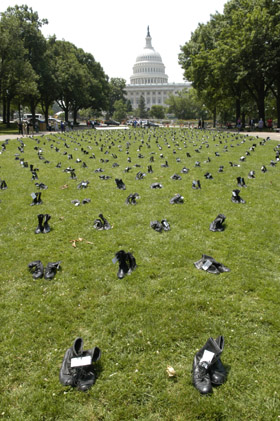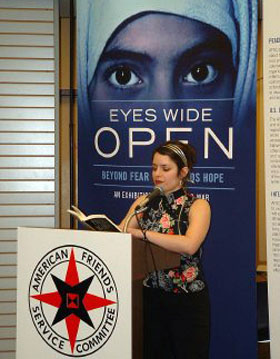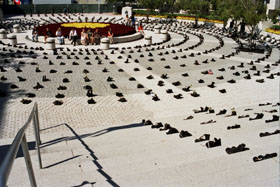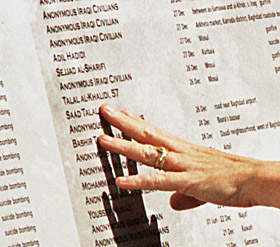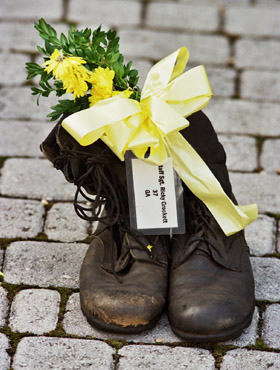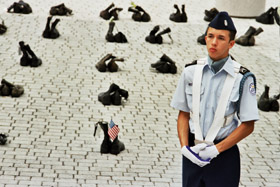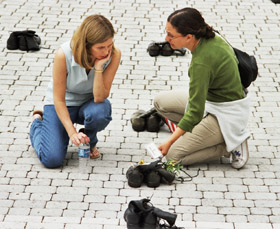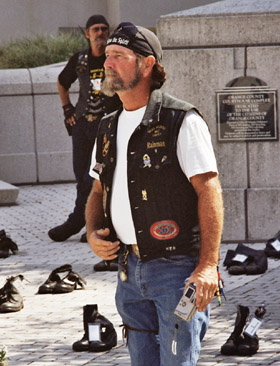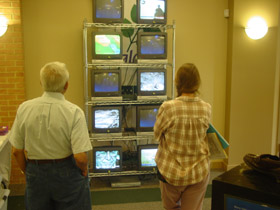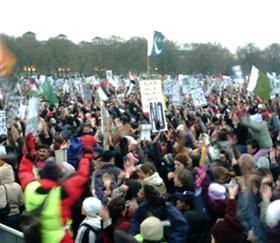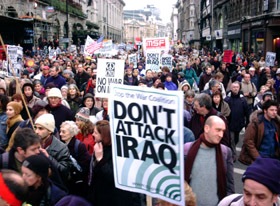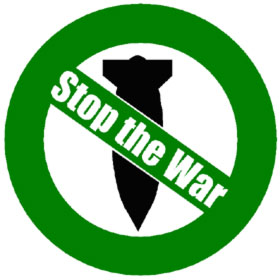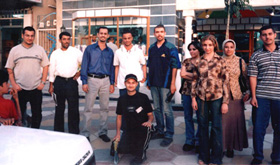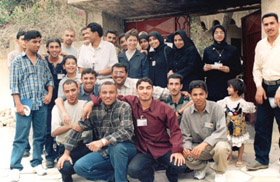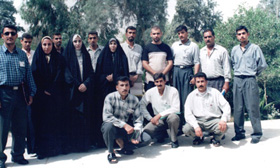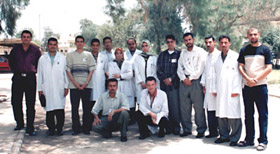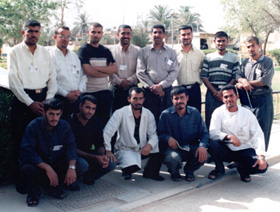Cross-National Commemoration In The Iraq War
By: Jon Brunberg | posted: 12/28/2004 1:00:00 AM
In Swedish
The designer of the Vietnam War Memorial in Washington DC, Maya Lin, was recently asked, in an interview in the Swedish magazine Arena, whether the memorial should have included names of the Vietnamese killed in the war alongside the names of the US soldiers. She replied, "Americans wouldn't have been prepared for that in those times and hardly today. The day when we can see everyone as victims and therefore none as enemies, that is the time when we can be prepared for such monuments" (1). The interesting thing is that there already are commemoration initiatives in the case of the Iraq war, in the US and the UK, that would memorialize all killed, regardless of their nationality, the side in the conflict they were participating on, and whether they were military personnel, civilians, aid workers or insurgents. While the Bush administration has of course been very careful to keep military funerals and the killed and injured away from the public eye, in order to avoid upsetting Americans (2), public commemoration has partly been taken over by independent groups, many among them opposed to the war. Military hardliners, veterans, and pro-war activists may not endorse commemorative acts arranged by groups advocating peace, but this is of less importance for the groups behind these initiatives since they are more focused on immediate action than everlasting monuments. With the ambition of bringing attention to the cost of war and filling the information vacuum created by a conformist and biased mainstream media, they have been able to create new types of cross-national memorials that are based more on humanism than patriotism.
The war in Iraq is perhaps the first full-scale inter-nation war in which casualties lists naming soldiers and civilians on both sides has been publicly available and used in commemorative events – this while troops are still engaged in battle. It may not be the first time that independent organisations and research groups have been able to collect data about the loss of civilian lives during conflict, but the Internet has allowed them to rapidly publish their results to a wide audience, and to efficiently counter the official claims from coalition forces that so-called surgical warfare spares civilian lives. Because of the hard work of a few activists, we now have at least part of the picture of the scale of the humanitarian disaster in Iraq.
The casualty list compiled by members of the Iraq Body Count project, and which is largely based on the results of the 'Iraqi Civilian War Casualties Survey' in cooperation with the US-based organisation CIVIC, has been the primary source in a few commemoration initiatives that have a clear polynational character. This article will focus on two of them, the 'Eyes Wide Open' exhibit that has been touring the US since January of 2004, and the name-reading ceremony 'Naming the Dead', that took place simultaneously on November 2, 2004 in the UK, Iraq, Italy, Switzerland, Spain, and Australia.
THE EYES WIDE OPEN EXHIBITION
The 'Eyes Wide Open' exhibition has become a very important event for the many Americans who believe that the reasons given for going to war in Iraq were gravely unjust, as well as for many of the relatives and friends of those killed. The exhibition has been arranged by the US organisation 'American Friends Service Committee' (AFSC), which is a Quaker peace and social justice action organisation, founded in 1917 as a service for conscientious objectors.
'Eyes Wide Open' is at the same time a travelling memorial and an information centre about the war in Iraq. It is made up of two parts, an indoor multimedia show and an outdoor exhibition. The former is described on AFSC's web page as "a multimedia, multisensory journey through the words, images, and sounds of the Iraq war. Visitors move through a vivid memorial to the war’s soldier and civilian victims and a compelling outline of what the war is costing us at home, that informs of the situation in Iraq." The outdoor exhibition is a powerful installation of almost 1300 pairs of army boots and around 1000 pairs of shoes. Each pair of military boots commemorates a killed US soldier and has a nametag attached to it. Each pair of "civilian" shoes represents 16 civilian deaths on the moderate end of the scale (3). On a wall consisting of three eight-foot panels, approximately 3000 dead Iraqi civilians whose names are known are listed. On some occasions AFSC has also organised name-reading ceremonies in remembrance of killed US soldiers and Iraqi civilians.
Mary Zerkel, who is the program coordinator of the exhibition, says that 'Eyes Wide Open' emerged from two initiatives. Michael McConnell, who is the Great Lakes Regional Director of AFSC, created an exposition in Chicago with 500 army boots in January 2004 to bring attention to the fact that over 500 US soldiers had been killed in the war. "'Eyes Wide Open' grew out of an ambition by a group of volunteers (which also included Mr. McConnell) at the AFSC office to do something to expose the unjust reasons for going to war in Iraq. They felt that nobody in the US, least the media, was talking about these things. After brainstorming the group came up with the concept for a multi-media exhibition." This initiative merged with the boot exhibit and then became 'Eyes Wide Open,' which has been touring the US ever since.
The numerous articles about the exhibition in the press, and the visitors' notes and documentation photographs on the organisation's web site make it clear that this is a very powerful initiative that enables people to express their emotions about the war in Iraq and mourn their loved ones publicly, maybe for the first time in the US on this scale, since the war began. Mary Zerkel says that the response to the exhibition has been overwhelmingly positive. She adds that there have been a few protests, and threatening emails sent to the organisation, but these are comparatively few. "People get very emotional when they visit the exhibition. Often relatives and friends of the killed are looking for the names of their loved ones and lay flowers and photographs by the boots." In some photographs from the exhibition, flowers are placed in a boot, sometimes together with an American flag, and photos of the dead and personal commemorative notes are attached to it. It reminds me of pictures I've seen from the Vietnam Wall where boots were placed in front of the black granite wall by relatives and friends. In ‘Eyes Wide Open’, the monumental wall has become secondary to the much more vulnerable and perhaps also more popular symbol of the military boot, which here becomes a small personal memorial in itself.
AFSC get numerous requests from all over the country to show the exhibition, from groups in big cities as well as small towns out in the country – many more than they possibly can handle. I ask Mary Zerkel what kinds of groups are requesting the exhibition. "A lot of Quaker groups do, because we are a Quaker organisation", she says, "but also local peace groups or teachers and students at universities. When there are several groups from the same town or area that want us to come we often ask them to form a coalition that will work with the exhibition. We are now booked until April, 2005, and a tour to the South and the west coast is coming up in a few weeks time." Today, ‘Eyes Wide Open’ has around one hundred volunteers, two paid full-time staff members, and one paid full-time coordinator.
"We try to make the exhibition wherever it is possible, because one problem is that the number of boots have grown so much that it's sometimes difficult to find a good location for them" says Mary Zerkel. "As of today, the military casualties are listed as 1297, so that's how many boots are in the exhibit. We stay very up to date with the numbers, sometimes adding boots as the day goes on. While we were in Chicago all day on September 16th, we added seven pairs of boots to the exhibit because that's how many deaths there were that day." The growing boot exhibit has meant that they can't always show the boots for the whole exhibition period, and sometimes they can only do it for one day.
Mary Zerkel says that the tour will continue as long as there is funding for it and that it is important to visit both big cities and rural areas. "Small towns are generally more conservative but there are still people there who are opposed to the war and it is therefore very important that we continue to go there." She explains that one of the reasons for the interest in the exhibition is that there is an enormous amount of people in the US that aren't by any means happy with the war. "There is really so little room for a critical discourse in the US media and people need to express critical views. What we are really doing is to provide a space for that."
It is indeed very interesting to learn from Mary Zerkel that AFSC is considering turning 'Eyes Wide Open' into a permanent memorial installation, even though she stresses that these are only very preliminary thoughts. "As the tour has been going on, people have started to look at 'Eyes Wide Open' as a national memorial." She also says that any permanent installation would have to get underway quite soon, but that it probably has to morph into something different. The boots are now so numerous that they require extra space, and as long as the war continues it will continue to grow. Such a permanent memorial could be located in Chicago or Philadelphia where the AFSC headquarters is located, but Mary Zerkel adds that this would be mere speculation at this point.
NAMING THE DEAD
Another recent example of cross-national commemoration of those killed in Iraq is the event "Naming the Dead" that was held on November 2, 2004, coinciding with the US national election. "Naming the dead" was a public commemorative ceremony, in which all published names of all civilians, soldiers, mercenaries and aid workers, regardless of nationality, who have died, was read by invited guests and the public. It was organised by the anti-war group "Stop the War Coalition" (StWC), which was also one of the main organisers behind the exceptional anti-war march that was held in London on February 15, 2003, when around 2 million people took to the streets to show the UK government, and the rest of the world, that there was solid public sentiment against the upcoming invasion.
Ms. Ruth Boswell, who lives in London, was the principal organiser of "Naming the Dead". By activating the coalition's worldwide network of peace groups she initiated an event that took place simultaneously in twenty cities in the UK, as well as the cities of Ancona, Bologna, Mantova, Siena, Milan, O'Artoteca and Naples in Italy, Zurich, Barcelona, Baghdad, and the cities of Adelaide, Sydney, and Brisbane in Australia.
Since she would be leading the ceremony in London, Ruth Boswell booked Trafalgar Square for the event and started to invite people and organisations to the reading. She says that she was fortunate because among those accepting the invitation were some prominent people. She mentions in particular the world-famous scientist Professor Stephen Hawking, who responded immediately. Since Prof. Hawking is suffering from ALS and is bound to his wheelchair, Ruth Boswell went with a camera crew to his department at Cambridge University to record him reading his part of the list. On that occasion Prof. Hawking told her that he was prepared to come down to Trafalgar Square and take part in the ceremony in person. Ruth Boswell says that this was the first time that he spoke about his feelings about the war publicly. His participation was also mentioned in news reports and on web sites all over the world. Associated Press quoted his speech saying, "the war was based on two lies. The first was we were in danger of weapons of mass destruction and the second was that Iraq was somehow to blame for Sept. 11. It has been a tragedy for all the families that have lost members. As many as 100,000 people have died, half of them women and children. If that is not a war crime, what is?" Another prominent protester, and probably the oldest one, was the 96-year-old Nobel Peace Prize laureate Sir Joseph Rotblat who resigned from his job developing the world's first atomic bomb on moral grounds in the 1940s.
Ruth Boswell says that her impression of that night is that it was a very powerful, beautiful and moving ceremony. A long list of people, ranging from politicians to school children, read one page each with names of the dead. The public was also invited to participate in the reading and cued up in front of the stage, which they entered one by one, told the public their name, and started to read. The ceremony lasted for five hours. It has been recorded on video and the coalition is also considering publishing a book documenting it.
I ask Ruth Boswell what StWC is planning for the future and whether we will ever see a two million man march against the war in London again. Ruth Boswell says that it's not likely and that the war is, in a sense, behind them now, even though there is a very strong sentiment against it in the UK. But, a march of that size could happen again in the event of a new war, for example in Iran.
"The big problem", says Ruth Boswell about the difficulties faced by civil society in the prevention of war, despite the strength of anti-war sentiment, "is that the elected leadership aren't prepared to listen to the electorate and that the only thing people can do really to change policy is to vote the elected out. Our group is based entirely on voluntary work and we can only react when things are happening".
Tony Blair has had a very rough time convincing his voters and even his party members that his actions were justified and the resistance against the war has been very strong, particularly in the UK but also in a lot of other countries. At the moment a group of MP's are running a campaign to impeach Tony Blair over the reasons given for going to war, and Ruth Boswell says that even though it is not likely that the campaign will succeed it is nevertheless important. Are we seeing a new, global, civil rights movement emerging from all these protests? "There have been protests all over the globe over this war, so it is a very strong movement and the government will have to barter with it. If Bush wanted to start a war with Iran, Tony Blair would find it very difficult to join him."
COLLECTING THE NAMES
The names of the coalition soldiers who have been killed have been readily available through many Western media sources since the start of the war. More notable is the work behind the list of killed civilian Iraqis that was used in the commemorations mentioned in this article, which is published on the Iraq Body Count's (IBC) web site and includes 3029 names. IBC are careful to note that the list is "the personal labour of IBC's archivist Kay Williams" and that it is "...not intended to be nor should it be taken as part of IBC's methodical team-based count of reported civilian deaths resulting from the military intervention in Iraq. It is also very much a work in progress..." (4) The major part of this list, 2000 names, was the result of a remarkable effort by the US-based organisation 'Campaign for Innocent Victims in Conflict' (CIVIC) in cooperation with a group of dedicated people who carried out the 'Iraqi Civilian War Casualties Survey' under difficult circumstances on the ground in Iraq. The result of the survey, which can be found on the group's web site, gives a chilling account of the suffering of ordinary Iraqis that no embedded journalist can match. The names of the dead and the detailed descriptions of when and how they were killed in itself constitutes an online memorial.
The director of the survey, Raed Jarrar, and his associates managed to gather a team of around 175 people who formed research groups that conducted door-to-door interviews to collect information about civilian deaths while CIVIC's general director Marla Ruzicka raised funds and managed media relations in the US. Salam Pax who is also known for being the "Baghdad Blogger", the most well-known civilian Iraqi voice from inside the country during the height of the war who now writes for the UK daily the Guardian, gives an account of the survey group’s work in a diary on the organisation's web site. "One of the biggest surprises when we got to Karbala was that Raed has a girl on his CIVIC team there. /.../ She told us about Um Khdair, who is a 30-year-old mother with 6 children. Her husband is 50, their house was bombed. He died and the house has been destroyed. Um Khdair and her 6 children now live in one room in a 'khan' (these are hotel-like buildings managed by mosques). She is pregnant as well. Sabah, the girl on the CIVIC team, tried to make Raed promise that he will do something, but he can't promise anything really. There is nothing worse than giving people false hope in situations like these and we remind the team not to give the people they interview any promises. CIVIC at the moment can only collect information and in extreme cases forward the info to an organization that has the funds and capability to help." (5)
EPILOGUE
What is going to happen when most of the coalition troops have pulled out of Iraq, and soldiers return to the US and the UK? From the controversy over the justification of the war, and the increasing amount of complaints from soldiers who are seeing their service periods in the army extended, their benefits cut and their visions of a noble cause shattered, we can already imagine that the aftermath of the Iraq war could be an embittered home front. It is perhaps naive to believe that these soldiers, and a majority of the US citizenry would be ready to commemorate civilian victims of the war as well, and even less so any killed insurgents, and it is absolutely unthinkable that the Bush administration, in particular, would even consider such a thing. Thus, I'm afraid I must agree with Maya Lin. What is nonetheless interesting is that the hawks in the US administration have themselves – by trying to hide the injured, the body bags and the coffins from the public gaze in their effort to present the glorious nation they describe in their 'Project for a New American Century' (6) – created the gap in which groups such as Stop the War Coalition and American Friends Service Committee are now operating. When the golden hue of that vision starts to look tarnished, it is going to be another tough match for them to regain lost territory on the home front. On that front, AFSC is already considering the creation of a permanent, national memorial in remembrance of soldiers and civilians on both sides because they feel that their initiative with 'Eyes Wide Open' has enjoyed wide support. There will perhaps be other voices that are going to try to get even more radical proposals for memorials on the national agenda. Such proposals would certainly spark controversy, but the efforts of the organisations mentioned in this article have already proven that polynational commemoration is no longer merely a vision, and that the road towards the realisation of that vision is already being travelled.
***
FURTHER READING AND LINKS
Stop the War Coalition
American Friends Service Committee
Eyes Wide Open
IraqBodyCount
CIVIC
Iraqi Civilian War Casualties Survey
An interview with Raed Jarrar conducted by Wendy Univer can be found at the ASFC web site and Jarrar's blog "Raed in the Middle" is also highly recommended for first-hand accounts of the situation in Iraq.
NOTES
1) Arena, Issue 3/04, June-July 2004, "Mullvadsarbete [Mole work]", Maya Lin interviewed by Fanny Söderbäck, pp. 32-34 (in Swedish)
2) Sunday Times Magazine, February 29, 2004, cover story: The Dying Game, pp. 36-43. The Sunday Times reports in this cover story about the obvious home front tactics to keep the killed from the public gaze and reports that president George W. Bush has not attended any military funeral since the start of the war.
3) The Iraq Body Count's figures, which are generally seen as moderate but reliable, are estimating that, as of December, 2004, between 14,770 and 16,965 civilians has been killed in the war. The medical journal The Lancet published a report in the end of October 2004 in which they estimate that as many as 100,000 civilians could have been killed in Iraq.
4) http://www.iraqbodycount.net/names.htm
5) http://electroniciraq.net/cgi-bin/artman/exec/view.cgi/14/817
6) 'Project for a New American Century' (PNAC) is a neoconservative American think tank that was founded in 1997 with the purpose to work for American global leadership. The bill of principles which can be found on their web site is signed by many members of todays Bush administration such as Cheney, Rumsfeld and Wolfowitz. PNAC's web site
Part of the series ''Issue #2 - the Iraq War Issue''
These articles relating to the war in Iraq were published in december 2004.
Editorials
• Counts and Commemoration
Features
• Cross-National Commemoration In The Iraq War• Counting the Dead - The Iraq Body Count Project

